
In early January, 2010, some people were jolted out of their sleepy breakfast routines by headlines like this (from a British newspaper called The Sun )

and this (from the PopSci website)
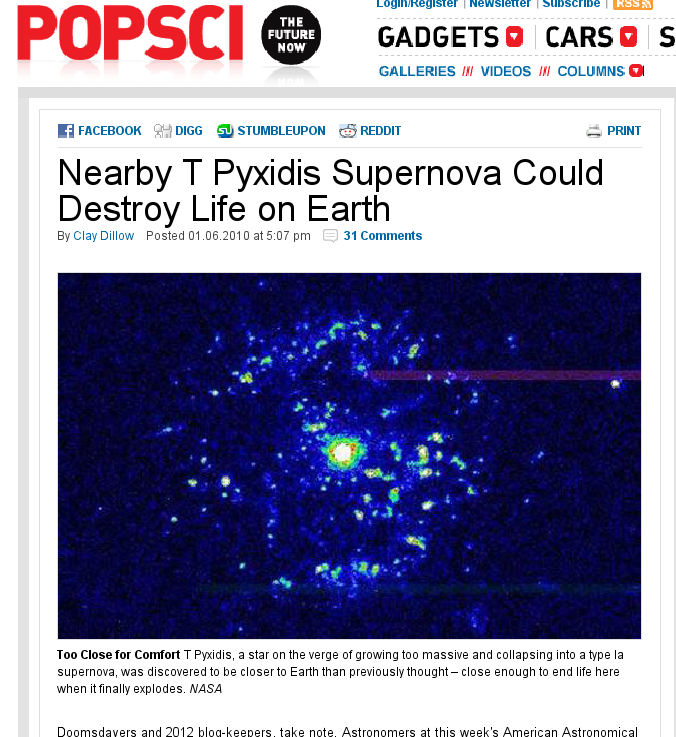
Yikes! Could this be true?
No, it's a mistake. But to understand the mistake, we should start at the beginning. What was the REAL story behind this headline?
It's not easy for us to see the constellation Pyxis, the Compass, from here in Rochester. It lies to the southeast of Canis Major, and really doesn't feature any bright stars at all.

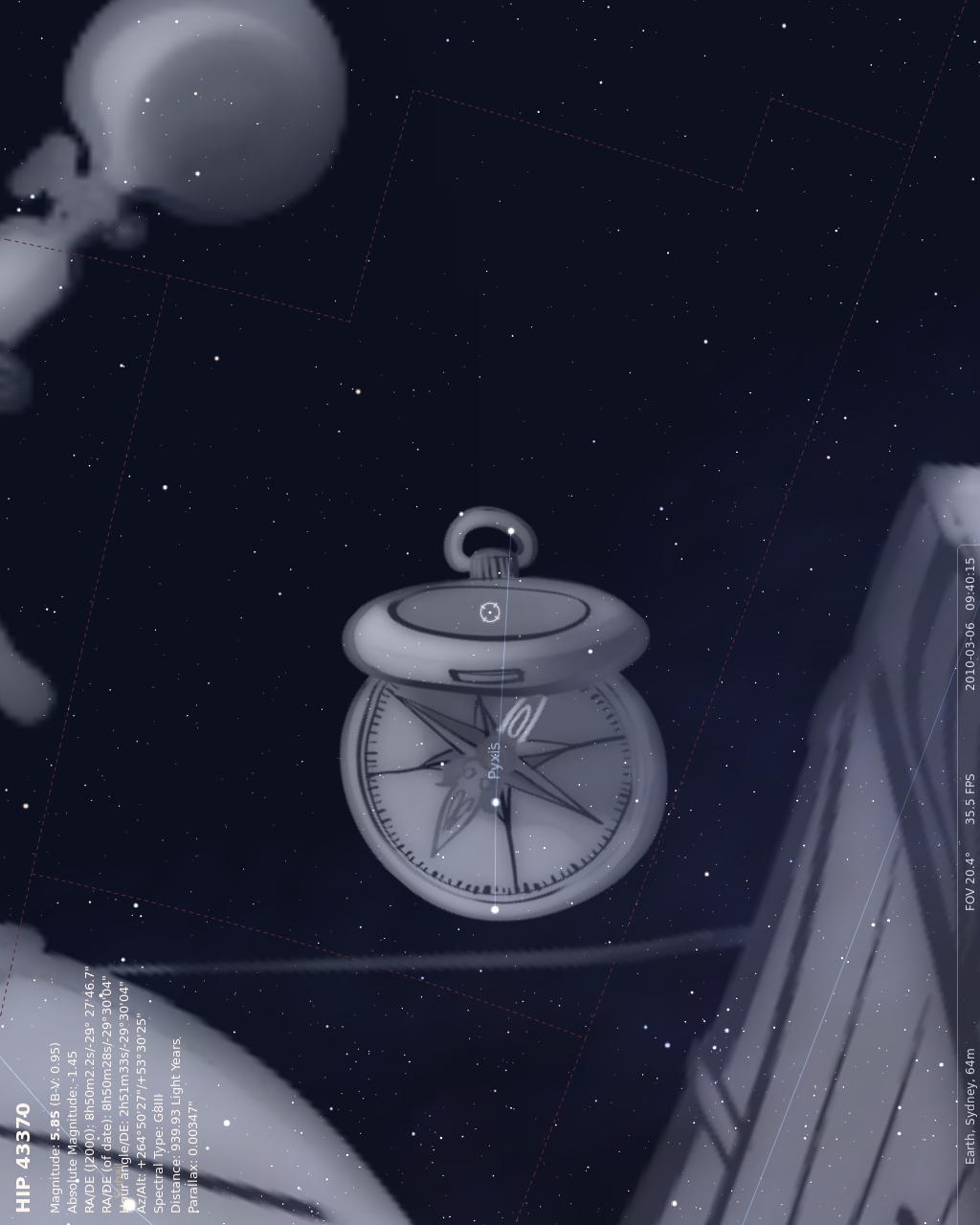
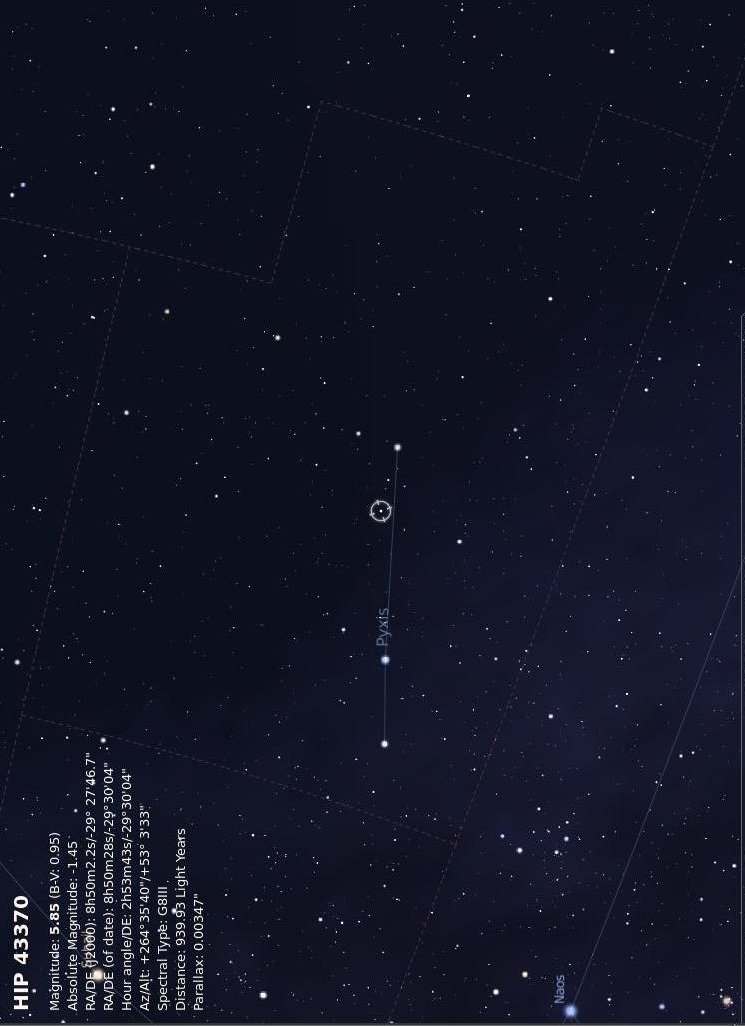
The star called T Pyxidis is even harder to find, since it is usually a faint little speck of light at around magnitude 15.
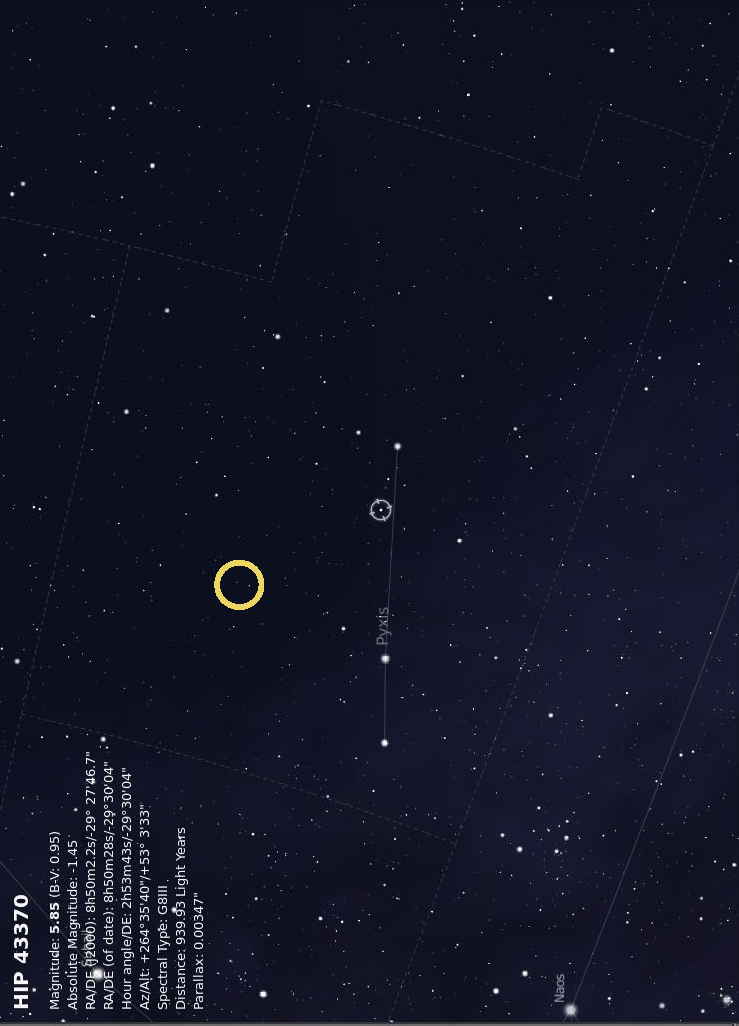
However, over the past few hundred years, this star has occasionally grown much brighter: in the years 1890, 1902, 1920, 1944, and 1966, the star could be seen with the naked eye (or close to it).
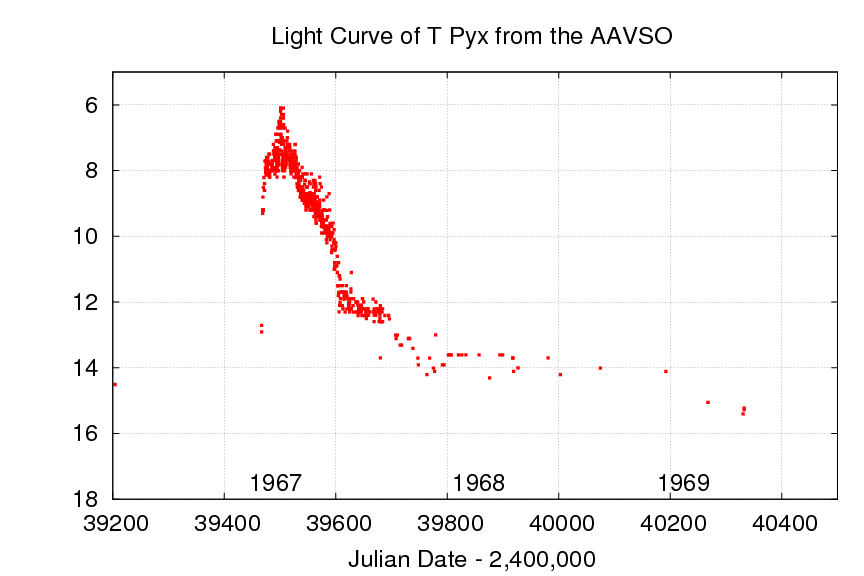
What causes these outbursts? T Pyx, it turns out, is not just a single star, but actually a close binary star system of the type called cataclysmic variables. A cataclysmic variable system consists of two stars orbiting around each other at close quarters: a white dwarf and an ordinary main sequence star. Some material ejected from the main sequence star is captured by the white dwarf and forms an accretion disk as it spirals towards its surface.
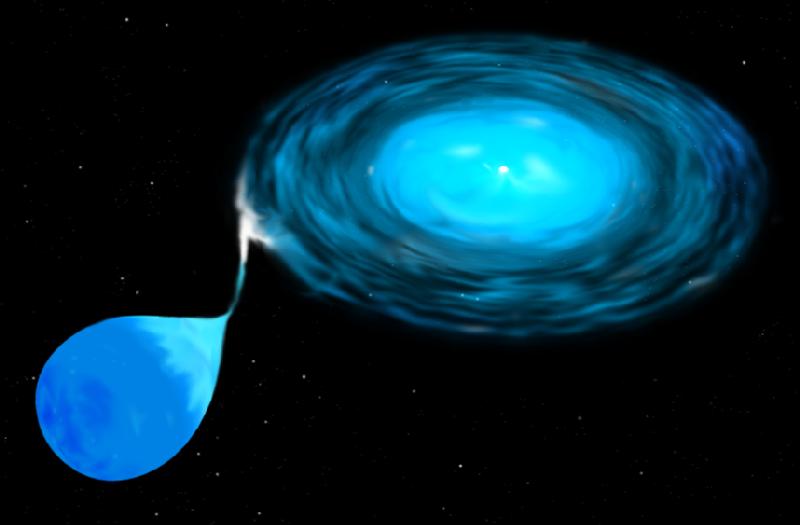
Some of the matter in the accretion disk does eventually settle down onto the surface of the white dwarf, creating a very thin layer of hydrogen (and a bit of helium). Over the years, as more and more gas reaches the surface, the layer gets deeper and deeper. The bottom layers of this gas are crushed downward by the weight of the upper layers, increasing their density and temperature. For some systems -- such as T Pyx -- the conditions at the bottom of the accreted material reach the ignition point: the hydrogen fuses into helium, releasing a big burst of energy. The explosion expels some of the layer of accreted material into space and heats it to temperatures of thousands of degrees. This nova glows brightly for several weeks to several months before fading back to its quiescent level.
If the conditions are just right, then not quite all the material is blown off the surface; the white dwarf gains a bit of mass. As the process repeats every decade, or century, the white dwarf grows more and more massive. If the white dwarf reaches a critical mass called the Chandrasekhar limit, which is about 1.4 solar masses, then thermonuclear reactions may begin deep in the star's interior. When the spread throughout the entire body of the white dwarf, the entire star is blown to pieces in a titanic Type Ia supernova explosion.
So, the thing to remember here is that
Even if the conditions are right to create a supernova, it would probably take a very long time for the white dwarf to accrete enough material to reach the Chandrasekhar limit -- millions of years, in all likelihood.
As you probably know, it's very difficult to measure the distance to stars. T Pyxidis is far beyond the practical limit for heliocentric parallax, and it isn't a simple, single, main-sequence star. Astronomers have tried to figure out how far away the system must be, but their estimates have varied quite a bit over the years.
1957 1900 pc apparent vs. absolute mag 1966 1050 pc interstellar absorption lines 1981 1000 - 4500 pc apparent vs. absolute mag 1982 1000 - 3000 pc expansion of shell 1989 highly uncertain expansion of shell 1995 3500 pc absorption in near UV 2008 3500 pc UV and X-ray measurements
The last couple of entries in the table are important: if T Pyxidis is really at the upper end of the distance range, 3500 pc away from the Earth, then it appears that the amount of material ejected in the most recent outbursts is GREATER than the amount of material accreted between outbursts. In other words, the mass of the white dwarf has been DECREASING recently, not increasing. That means that T Pyx might not become a supernova after all.
Distance = 3500 pc --> no supernova
This argument was put forth by Selvelli et al., A&A 492, 787 (2008) in their paper The secrets of T Pyxidis II. A recurrent nova that will not become a SN Ia .
Okay, we've set the stage. There's a binary star system called T Pyxidis which is the sort of star that might turn into a Type Ia supernova ... but the accretion rate during quiescence appears to be smaller than the mass loss rate during nova outbursts. So, one would conclude on Jan 3, 2010, that T Pyx would NOT become a supernova.
However, Ed Sion and his collaborators Patrick Godon and Timothy McClain were prepared to change this conclusion. They had improved models of the double-star system, using sophisticated computer codes to track the journey of radiation as it passed through the accretion disk in detail. Here's the abstract of their presentation, number 416.26 at the AAS meeting.
The recurrent nova T Pyxidis has had 5 recorded thermonuclear explosions, more than any other recurrent nova, with an average time between nova outbursts of 19 years. However, it has been 44 years since its last nova outburst in 1966, making it long overdue for the next nova (supernova?). Our preliminary synthetic spectral analysis with the use of realistic, optically thick accretion disk models with vertical structure demonstrates that the far ultraviolet continuum energy distribution of T Pyx is completely dominated by a steady state optically thick accretion disk for E(B-V) = 0.25, i = 18 degrees, a near-Chandrasekhar mass white dwarf and a canonical accretion rate 10-8 Msun/yr but that the distance to T Pyx with these best-fitting parameters is only 1 kpc, not the widely assumed distance of 3.5 kpc. Assuming a distance of 3.5 kpc leads to extremely poor model fits and a lower than anticipated accretion rate. Moreover, the envelope mass for white dwarfs as massive as 1.37 Msun is possibly as low as 10-7 Msun, which is also the amount of mass that is needed to achieve thermonuclear ignition. Unless T Pyx is extremely young and was born as a CV below the period gap with a near-Chandrasekhar mass white dwarf, then it is close to the critical mass for a Type Ia supernova event, the kind of supernova used as a standard candle to demonstrate that the expansion rate of the universe is accelerating. Our preliminary work supports the scenario that the white dwarf is continuing to increase its mass and is perilously close to a Type Ia supernova explosion. We discuss the potentially far reaching implications of our results.
So far, so good. Their work indicates that the absorption of light within the accretion disk is larger than was previously thought.
More absorption in accretion disk -->
less light escapes into space -->
star must be closer than previously thought -->
parameters of the system change -->
will turn into a Type Ia SN after all
The problem occurred when the authors examined the consequences of a Type Ia supernova exploding at a distance of about 1000 pc from the Earth. It's true that a Type Ia supernova emits a huge amount of high-energy radiation -- X-rays and gamma-rays -- which would indeed to deadly to any life nearby. However, we know roughly how much energy a supernova emits, and we can calculate how large a flux reaches an observer at any particular distance. It turns out that the critical distance for a Type Ia supernova is something like -- a rough estimate is the best we can do -- a few hundred parsecs, at most; it might be less than 100 pc. We're really not sure, since we have very few good measurements of the X-rays and gamma-rays from Type Ia supernovae, and because we don't understand very well how the high-energy radiation would interact with the Earth's atmosphere and with the Earth's flora and fauna.
The bottom line is that, while a Type Ia supernova at a distance of 1000 pc would be quite a dramatic sight in the sky -- it would shine at an apparent magnitude of about -9! -- it wouldn't pose any danger to life on Earth.
For example, humans in China, Korea, Japan, the Middle East and Europe all recorded a very bright supernova in the year 1006 which might have reached apparent magnitude -9. This supernova was likely a Type Ia, and likely at a distance of no more than 2000 pc. Life survived that event, so it would survive one at 1000 pc, too.
But that's not what Sion claimed at the meeting. Here's a copy of the final slide from his presentation:
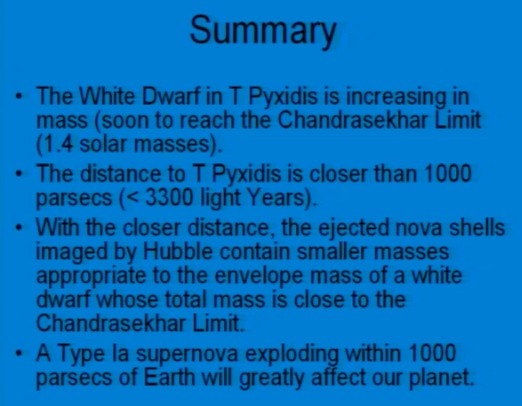
Note that final sentence: will greatly affect our planet. A science writer at the presentation wrote the following:
Gamma radiation emitted by the supernova could threaten the Earth with an energy equivalent to 1,000 simultaneous solar flares. The production of nitrous oxides in Earth's atmosphere by the gamma rays could completely destroy the ozone layer, astronomers said.
Here's another quotation from another reporter at the presentation; I have read that this paragraph is actually the final paragraph of the official press release.
An interesting, if a bit scary, speculative sidelight is that if a Type Ia supernova explosion occurs within 1,000 parsecs (1 parsec = 3.26 light-years) of Earth, then the gamma radiation emitted by the supernova would fry the Earth, dumping as much gamma radiation (~100,000 ergs/square centimeter) into our planet, which is equivalent to the gamma ray input of 1,000 solar flares simultaneously.
Wow. That sounds bad.
But it's a mistake. As Ian O'Neill writes ,
During Sion's presentation, he was challenged by one of his peers in the audience, Prof. Alex Fillipenko from Berkeley Astronomy Department. Apparently Sion had possibly miscalculated the damage that could be caused by a T Pyxidis supernova.It seems that Sion had used data for a far more deadly gamma-ray burst (GRB) exploding 3,260 light-years from Earth, not a supernova. T Pyxidis certainly isn't expected to produce a GRB. (Gamma-ray bursts are thought to only be generated by a massive star that has reached the end of its life as a Wolf-Rayet star collapsing under its own gravitational attraction.)
The energy released by a Gamma-Ray Burst (GRB) is much, much larger than that released by a Type Ia supernova, especially within the narrow beams which come out of GRBs. GRBs may release more than 1051 ergs of energy in the form of gamma rays, within a few minutes. SNe Ia, on the other hand, slowly release a total of around 1047 (at most) ergs of high-energy radiation over the course of a month or so.
Whoops. This little point of confusion -- attributing the power of a GRB to a supernova -- leads to a mistake by a factor of 10,000 or more!
This is an example of "science by press release", rather than "science by peer review." It's the scientific equivalent of "going commando", I suppose: the risk is high, but the potential reward is .... uh, well, what _is_ the potential reward?